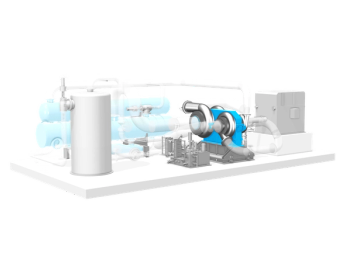
Handling performance test results for variable-speed multi-casing turbocompressors
The final validation of a Variable-Speed (VSD) multi-casing turbo-compressor trains should be done at its manufacturing shop with a full-speed, full-load test, preferably including ASME PTC-10 Type-1 performance test. This is an extremely important set of tests where the performance and running of the turbo-compressor is verified and evaluated.
Rotor-dynamic, Torsional & Overall Dynamic
Dynamic aspects and the vibration have been critical topics for multi-casing turbo-compressors. There have been many reported issues associated with high vibration, rotor-dynamic issues, torsional vibration, etc. The validation of the rotor-dynamic, torsional and different dynamic aspects of such a machinery is extremely important and this should be done at the shop running and performance tests. During this set of testing, torque pulsation measurements should also be conducted for the validation of torsional analysis and pulsation amplitudes under the steady state and transient conditions (such as start-up, different operating cases, etc).
Head & Efficiency Curves
Performance curves of a turbo-compressor are usually theoretical predictions until the performance test. At the performance test, the theoretical curves should be evaluated and validated. For the performance test, all curves including the head an efficiency curves should be considered. Too often, curve set of the test performance (head and efficiency), is slightly lower than the theoretical expected curves. This is because the current sophisticated theoretical formulations and simulation techniques used by experienced vendors are in way to simulate the compressor performance accurately but not conservatively. This is to limit costs. Therefore, the performance test is usually resulted in a slightly lower than theoretical (expected) curves. However, there have been some exceptions, and the test result might be slightly more than expected ones or there could be a drastic deviation. If there is a significant mismatch, there could be a serious mistake in the theoretical predictions. The possibility of such case is very low. Practically, in many cases, performance test curves sit just slightly below the theoretical curves.
If there is a Mismatch?
If all stages show slightly lower or higher head compared to the expected head, there could be a speed adjustment to solve the mismatch and reaching an optimum efficiency. This is a great advantage of a VSD driven turbo-compressor. For example, in a case study, the rated speed of compressor was 1.2% increased to achieve the required performance curve, the head required and optimum efficiency.
Sometimes one or more stages of a compressor show extra head and similar polytrophic efficiency in line with expected values, whereas other stages show heads lower than expected ones. Such a situation is usually more difficult to deal with since whole the compressor train should be operated with the same speed. On one hand, the situation might be in a way that the overall head (head at the discharge) might remain more or less the same. Or the overall compressor performance (overall head, etc) might be achieved by a small speed adjustment. On the other hand, the overall efficiency might be low or there might be some constraints on inter-stage conditions. In those cases, special methods such as trimming impellers have been proposed with great promises. However, such trimming modifications can be expensive and risky; these should be limited to very special cases.
When some stages show lower head and others show higher head than expected ones, a careful evaluation is needed to find the best solution. The final solution in such a situation might be limiting the overall map of the multi-casing compressor. Looking at the overall curve, it may raise a concern being the revised curve shorter on the left or right (or both). Particularly attention is needed for the left side, the area known as high pressure range (near the surge).
Depending on characters of the compressor, the limiting of the curve may or may not be a real concern. There may already be other limiting factors and this set of imposed limits as the result of the performance test may not restrict the actual operating range. Regarding the left side of a compressor performance curve (so called high-pressure section), the final discharge pressure is usually limited by a high-pressure trip and on a higher level, by the pressure set point of the pressure relief valves (PRV). On the right side of the compressor performance curve (so called over-flow section), there are always some limits on the maximum flow that the downstream system can handle.
Precautions at Bidding Stage
With respect to difficulties experienced in previous compressor performance tests, there could be points or lesson learned to consider at the bidding stage to deal with uncertainties of the actual compressor performance. It should be well understood that the curves and offered compressor performance at the bidding stage are just estimates and theoretical predictions and there might be some limitations and changes as the result of actual performance tests. With respect to the abovementioned cases, the following guidelines can be drawn for the bidding stage (during the selection and purchase order) to order a turbo-compressors that can properly deal with such possible situations at the shop/site performance test:
- The speed variation range should be relatively wide, for example, 60-105% of normal speed (if possible) to deal with uncertainties in the performance test and any mismatch between the test (actual) performance and the expected theoretical performance.
- The stage curves and overall performance curve should be properly wide. The overall performance curve at the bidding stage is just an expected set of curves and this might be trimmed by the actual performance of the compressor. Therefore, in theory, the curve should be sufficiently wide in a way that if in worse possible case, it will be restricted, it can still offer a reasonable operational flexibility.
Newsletter
Power your knowledge with the latest in turbine technology, engineering advances, and energy solutions—subscribe to Turbomachinery International today.





